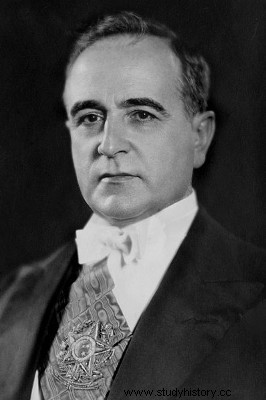
By Me. Cláudio Fernandes
Getúlio Vargas (1882-1954) he held the presidency of the country, at first, for fifteen years:from 1930 to 1945. Then he returned to the same post in 1951, ruling for another three years, in a very different context, and leaving only in an unconventional way, that is, , committing suicide. The term “Was Vargas” it is used precisely to accentuate this long permanence in power. Vargas ascended to the presidency in 1930, in a context of saturation of the political model that prevailed until that moment, the so-called “Old Republic”, whose rotation of power was disputed by leaders of the states of São Paulo and Minas Gerais.
Representatives of some of the oligarchies regional contrary to the measures of the then president Washington Luis, of São Paulo, united with the Army, which was also demoralized since 1924 due to the Revolt dos Lieutenants, to depose the President of the Republic. This atmosphere of political turmoil became known as the “Revolution of 1930”. Vargas, who was governor of Rio Grande do Sul, became, at that moment, the president in charge of organizing the Republic.
The main characteristics of the beginning of Vargas' role as president were:1) the centralization of political power and the consequent weakening of regional oligarchies, especially in São Paulo; 2) economic modernization, especially after the Crisis of 1929 , which demanded an acceleration in the import substitution policy, that is, the production of industrial machinery on Brazilian soil, which resulted in the development of the steel and metallurgy sectors; 3) facing the dissatisfaction of São Paulo, which demanded a Constituent Assembly – since Vargas ruled “provisionally” in support of the Army and had dissolved the Legislative Power.
In 1932, the state of São Paulo rebelled against the central power of the Republic, an episode that became known as the “Revolution Constitutionalist from 1932”. Vargas, taking advantage of the action of the National Army, put down the São Paulo insurgency. However, the pressure for a Constitution continued and, in 1933, a Constituent was convoked that defined the new Constitution, in 1934, through which Vargas was indirectly elected to the presidency. In the following year, a new revolt was articulated against the government of Getúlio, this time that of the communists, who were led by Luiz Carlos Prestes. The “Intent Communist" , of 1935, set a precedent for Vargas and the army generals to plot the coup that kept him in power until 1945.
The “State New” – the explicitly dictatorial phase of Getúlio Vargas – was instituted on November 10, 1937. The 1934 Constitution was revoked, and the country was deprived of elections and freedom of expression, in addition to being subjected to strongly fascist control. inspired by the European authoritarian leaders of the same time, Mussolini and Hitler. However, one of the highlights of the “Estado Novo” period was the creation of labor laws through the CLT (Consolidation of Labor Laws), approved on May 1, 1943.
With the end of World War II and the fall of the fascist regimes, the Vargas “New State” went into crisis, as its authoritarian format of government suffered a great loss of prestige. In this way, the same military junta that helped Getúlio Vargas to build his dictatorship ended up deposing him from power. Although the gaucho politician had articulated, in 1945, the so-called “queremismo” (a popular movement in favor of his permanence in the presidency of the Republic, which shouted the slogan “We want Getúlio!”), he could not avoid his removal.
Getúlio returned to power in 1951 after contesting the democratic elections of 1950, in a context, therefore, very different from the one in which he remained in power for fifteen years. However, he did not finish his term. Pressured by various sectors of society, mainly by journalist and politician Carlos Lacerda, to resign due to the populist measures that he had been adopting in his government, Vargas decided to give a tragic end to his trajectory, shooting himself in the heart on August 24, 1954.
______________________
*Image credits:Commons
Take the opportunity to check out our video lessons related to the subject:
